|
Report from
Europe
EU veneer market showing signs of recovery
Preliminary analysis of Eurostat data indicates that the
European veneer market, which was in decline between
2010 and 2014, staged a partial recovery in 2015.
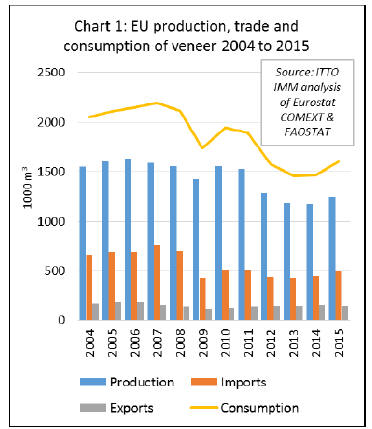
Total EU veneer consumption increased by 9% from 1.47
million cu.m in 2014 to 1.60 million cu.m in 2015. This
rise was driven both by a 7% rise in domestic production,
from 1.17 million cu.m to 1.25 million cu.m, and a 12%
rise in imports from 448,000 cu.m to 500,000 cu.m (Chart
1).
Slowly improving economic conditions in Europe have
contributed to rising veneer consumption in key sectors,
including veneered panels and flooring. There are also
encouraging signs that veneer manufacturers may be
making more progress to regain share lost to non-wood
alternatives in recent years through innovations in
processing to further improve resource efficiency and to
develop new products.
3-D veneers are now ell established in Europe and have
extended real wood veneers into applications previously
dominated by plastics. As larger industrial markets for
standardised veneer products have declined, there has also
been a strong emphasis on more flexible servicing of
smaller customer specific requests.
European oak in short supply
Nevertheless, anecdotal reports suggest 2015 was another
challenging year for the European veneer sector.
Throughout 2015 and continuing into 2016, European
veneer mills were suffering from shortages of veneer
grade oak logs.
This was particularly the case for manufacturers of massproduced
veneers for veneered panels and furniture.
Various factors contributed including intense competition
in oak log procurement from barrel manufacturers and
buyers in Asia and the relative weakness of the euro in
2015 which encouraged more focus on European oak,
increasing the costs of imported logs while also making
European oak more attractive to mills outside Europe.
Another significant development in 2015 was passage of a
law in Ukraine on 9 April 2015 which imposed an export
ban on unprocessed timber for 10 years effective from 1
November 2015 for all species (with the exception of pine
banned from 1 January 2017).
While the law only became effective later in the year, it
seems to have had an immediate impact to reduce EU
imports of hardwood logs, particularly oak, from Ukraine.
EU imports of Ukrainian oak logs were only 29,000 cu.m
in 2015, down from 82,000 cu.m the previous year and
figures closer to 200,000 cu.m prior to the economic
crises.
While there was pressure on European oak supplies in
2015, the same cannot be said for other European
hardwood species. Under-utilisation of beech remains a
significant problem in Europe, while markets for other
more specialised species have come under intense pressure
from substitute materials. For example, large furniture
manufacturers will only use ash veneers if they remain
cost-competitive compared to artificial heavily structured
surfaces.
EU exports of veneer have also came under pressure,
declining 4% from 155,000 cu.m in 2014 to 149,000 cu.m
in 2015, particularly due to a downturn in sales to Turkey,
Morocco, Russia, and China. Recent market reports
suggest this trend has continued into 2016.
EU veneer imports expanded in 2014 and 2015
Chart 2 shows the long-term trend in imports of all veneer
into the EU from outside the region between 2004 and
2015. It highlights the large drop in imports during the
financial crises in 2009.
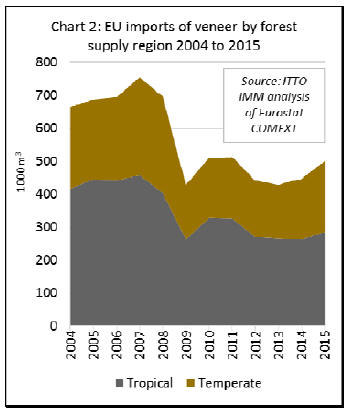
After a partial recovery in 2010 and 2011, imports
weakened in 2012 and 2013 but then rebounded again in
2014 and 2015.
EU imports of veneer from tropical countries increased
9% from 263,000 cu.m in 2014 and to 287,000 cu.m in
2015. Tropical countries accounted for 57% of all EU
imports of veneer in 2015, down from 59% the previous
year and 64% in 2010. EU imports of veneer from
temperate countries increased 16% from 185,000 cu.m in
2014 to 215,000 cu.m in 2015.
The most noticeable trend in EU temperate hardwood
veneer imports during the last five years has been a rise in
volume and share from Ukraine, Russia and Serbia. The
rise in Ukraine¡¯s share accelerated in 2015, likely related
to the restrictions on log exports from that country.
Recent trends in EU imports of tropical hardwood veneer
are strongly influenced by events in the plywood industry
(Chart 3). The short-lived recovery in EU tropical veneer
imports in 2010 and 2011 was primarily due to rising
exports of rotary okoume veneers from Gabon to supply
the European (mainly French) plywood manufacturing
sector after Gabon imposed a total log export ban in May
2010.
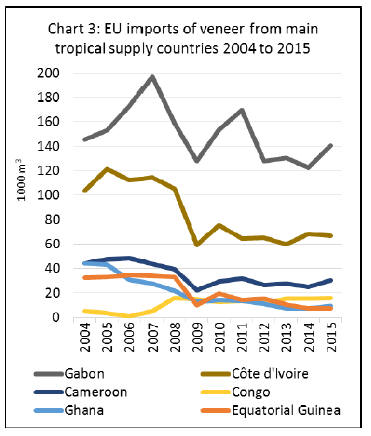
The uptick in EU imports of tropical veneer in 2015 was
mainly due to imports from Gabon, which increased 15%
to 141,000 cu.m, with much of the volume destined for
France. Demand for okoum¨¦ plywood picked up in Europe
in 2015 due primarily to recovery in the Netherlands
building industry and slow improvement in the French
market.
The French company Rougier which produces okoum¨¦
veneers and plywood in France and Gabon, booked a 9.8%
increase in revenues in its European business during 2015.
Rougier reports an improved economic climate in Europe
in 2015, a trend which continued into the first quarter of
2016.
In addition to Gabon, EU imports of tropical veneer also
increased during 2015 from Cameroon (+21% to 30,200
cu.m), Congo (+2% to 15,700 cu.m), and Ghana (+26% to
9,400 cu.m). However imports from Côte d'Ivoire declined
2% to 66,800 cu.m.
Double digit growth in French and Italian tropical
veneer imports
Imports of tropical veneer into France and Italy, now the
largest EU markets for tropical veneer, both registered
double-digit growth in 2015, rising 15% to 116,258 cu.m
and 19% to 67,626 cu.m, respectively. There were also
significant increases in imports by Greece (+29% to
16,494 cu.m) and Romania (+37% to 14,860 cu.m).
Of the five largest EU markets for tropical veneer, Spain (-
14% to 36,608cu.m) was the only to report declining
imports in 2015. However, imports also declined into
Germany (-17% to 14299 cu.m) and Belgium (-44% to
7107 cu.m) during the period.
The positive trend in EU imports of veneer from tropical
countries continued into 2016 (Chart 4). Imports were
73,300 cu.m in the first quarter, up 14% compared to the
same period in 2015. Imports increased from all the main
supply countries during the period including Gabon (+6%
to 36,900 cu.m), Côte d'Ivoire (+11% to 16,800 cu.m),
Cameroon (+45% to 5,900 cu.m), Congo (+72% to 5,100
cu.m) and Ghana (+42% to 2,800).
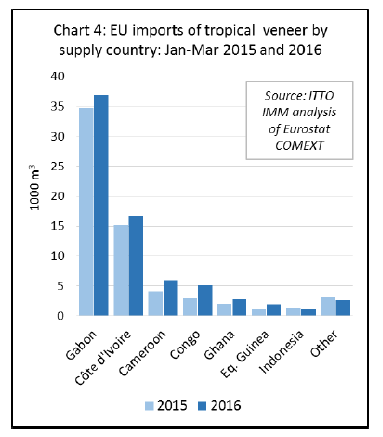
All the largest EU markets for tropical veneer have been
importing more this year (Chart 5).
During the first quarter of 2015 compared to the same
period in 2014, imports increased into France (+3% to
30,100 cu.m), Italy (+44% to 16,400 cu.m), Spain (+31%
to 10,700 cu.m), Greece (+30% to 4,700 cu.m), Germany
(+17% to 4,200 cu.m), and Belgium (+175% to 2,400
cu.m). These gains offset a 70% decline in imports by
Romania to just 1,400 cu.m.
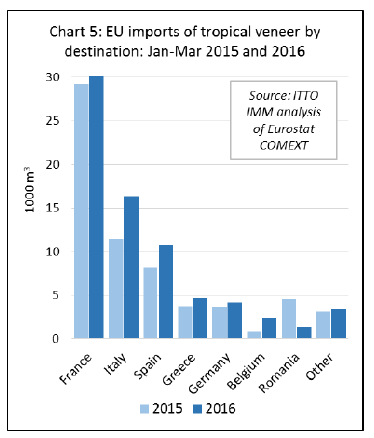
STTC Conference on tropical timber purchasing
policies
The title of the European Sustainable Tropical Timber
Coalition (STTC) conference on June 23 is ¡®Real Impact
Through Timber Purchasing Policies. The free-entry, oneday
event in Rotterdam tackles sustainable timber
purchasing policy implementation and building market
demand for sustainably sourced tropical wood products. It
is organized by Probos, with supporters including STTC
principal partner the ETTF, the City of Rotterdam, Dutch
Infrastructure and Environment ministry and local
government sustainability body ICLEI.
The first session features keynote speakers on how
procurement can shape and grow European sustainably
sourced tropical timber sales and this can drive spread of
sustainable forest management in supplier countries.
Afternoon breakout discussion workshops will look at
¡®Timber Procurement Policies in Practice¡¯.
Topics for private sector delegates will include the
STTC¡¯s activities and future development, barriers to
sustainable tropical timber becoming mainstream, tackling
price differential between certified and non-certified
timber, product substitution and image.
More information can be found at
www.europeansttc.com
For more contact Joyce Penninkhof
joyce.penninkhof@probos.nl
Italy sets minimum requirement for certified or
recycled timber in public procurement
Italy¡¯s timber sector has seen advantages for the industry
in a new law that at least 50% of wood products procured
by government for public projects should be certified legal
and sustainable, or recycled.
The regulation was passed at the end of 2015 and came
into effect earlier this year. Its full title is ¡®Environmental
provision to promote green economic measures and
contain excessive use of natural resources¡¯.
The new law stipulates that all public sector bodies ensure
that at least half of tenders for timber and wood products
by value meet a range of environmental criteria,¡± said
Stefano Dezzutto, Chief Executive of timber sector
federation Fedecomlegno.
He added that the new ruling currently covers office and
outdoor furniture, construction materials, windows and
doors and said Fedecomlegno consulted on the drafting
process.
Proof of origin can include FSC or PEFC certification,
these schemes¡¯ recycled wood certificates, or an
equivalent, which has to be independent third party
verified and ISO-approved.
Fedecomlegno sees the new regulation boosting overall
Italian demand for certified sustainable timber, especially
wood-based panels used in furniture. It has also
communicated the details to its members so they can be
prepared.
SMEs target of NEPCon due diligence training
According to a report by ETTF, a new pan-EU training
programme aims to make EU Timber Regulation (EUTR)
due diligence part of the ¡®standard way of doing¡¯ business
for small to medium sized enterprises (SMEs).
The EU-funded initiative, ¡®Increasing awareness and
capacity to support effective implementation of the
EUTR¡¯, is being organised by not-for-profit international
sustainability organisation NEPCon, with support from the
Global Timber Forum.
The training courses, led by NEPCon experts, are free for
and tarket timber sector SMEs. Delegates will also receive
due diligence tools to take away, plus new risk assessment
information for 40 supplier countries globally, accounting
for 90% of Europe¡¯s timber imports. This data is also
available to EUTR Competent Authorities and Monitoring
Organisations.
NEPCon says the training aims to make due diligence ¡®an
integral element in a company¡¯s administrative systems ¨C
even a business opportunity¡¯. It is also undertaking a
survey of to further assess EUTR businesses' compliance
needs (see
http://www.surveygizmo.com/s3/2817275/Legal-timberin-
the-EU).
¡°Due diligence is, at heart, good business practice,¡± said
NEPCon. The project's ultimate aim is consistent
implementation of the EUTR by EU SMEs. The courses
will be run in Belgium, Denmark, Estonia, Germany,
Holland, Latvia, Lithuania, Poland, Portugal, Rumania,
Slovakia and Spain.
¡¡
Call for Tenders: Support services for implementing
the EU Timber Regulation and FLEGT Regulation
The Call for Tenders "Support services for implementing
the EU Timber Regulation and FLEGT Regulation" has
been published.
Time limit for receipt of tenders is 11 July 2016. The
purpose of the contract is to provide support to the
European Commission in assisting the EU Member States
in monitoring the implementation and enforcement of the
EU Timber Regulation (EUTR) and EU Forest Law
Enforcement Governance and Trade (FLEGT) Regulation
and in carrying out the specific tasks required from them
by the Regulations, through monitoring trends in trade in
timber and timber products, report preparation,
compilation and analysis, monitoring implementation and
enforcement measures, information to the public, and
participation in meetings.
All relevant information can be found
here: https://etendering.ted.europa.eu/cft/cftdisplay.
html?cftId=1568
https://etendering.ted.europa.eu/cft/cftdisplay.
html?cftId=1568
|